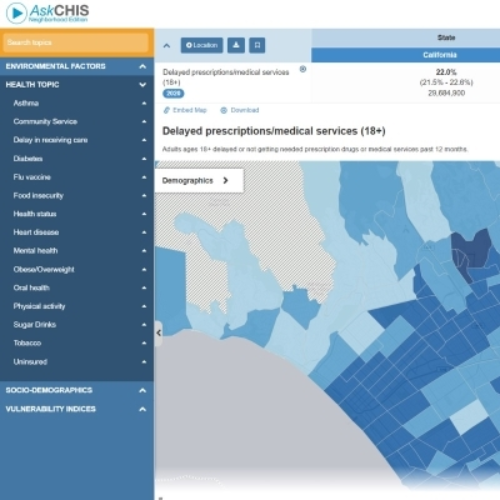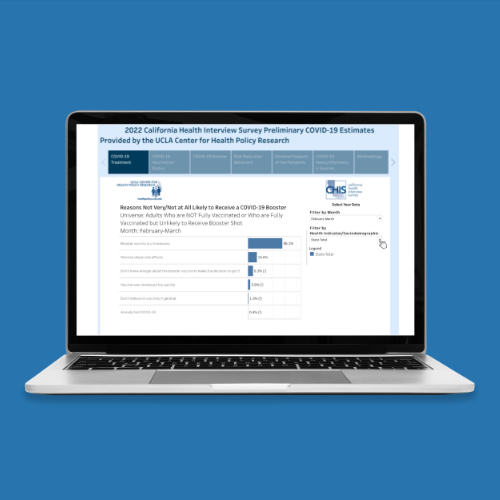COVID-19 rapid response: How the California Health Interview Survey adapted during the global pandemic
The American Journal of Public Health published a study by Dr. Ninez Ponce about how the California Health Interview Survey responded to COVID-19.

How was the California Health Interview Survey (CHIS) team able to release early data for the first time in the survey’s history?
Research published in this month's edition of the American Journal of Public Health looks at how CHIS was able to adapt to the COVID-19 pandemic by releasing timely data on how Californians navigated the pandemic’s conditions and challenges.
As a large, well-established statewide population survey, CHIS researchers released early data from the 2020 survey through the CHIS COVID-19 Preliminary COVID-19 Estimates Dashboard beginning in September 2020. These included questions in a COVID-19 module that began in May 2020. The team finalized the module in April 2020 and included indicators on COVID-19 concerns, testing, and diagnoses, as well as financial and social impacts of the pandemic and personal acceptance of the vaccine.
Decades of survey collection, the survey’s redesign in 2019 to dual-mode administration by web or telephone and stakeholder engagement were the main contributing factors as to how CHIS successfully adapted to the pandemic and produced timely data related to Californians’ response to the pandemic.
“As the pandemic glaringly exposed inequities across sociodemographic groups in health access and outcomes across the state and nationwide, our goal was to provide timely, equity-focused data in a more rapid processing timeframe to meet the demand for insights needed during this unprecedented time,” said Dr. Ninez Ponce, UCLA Fielding School of Public Health professor of health policy and management and CHIS principal investigator.
With the support of CHIS’ data partner, SSRS, and questions from COVID-19 surveys conducted by agencies such as the Centers for Disease Control and Prevention (CDC), researchers were able to report preliminary monthly estimates from methods that typically support annual data metrics. Authors note that challenges did occur in that samples may not have been representative of certain geographic areas or demographic groups due to response rates within certain areas or groups, inability to compare data on a month-to-month basis, and statistical instability of some of the data estimates.
Overall, CHIS successfully demonstrated the possibility of releasing data from the annual survey in rapid time and the ability to respond to a crisis by providing crucial, actionable data to various stakeholders, such as policymakers, program managers, community health workers, and the general public, to help identify residents most impacted by the pandemic. Beginning July 2021, CHIS began releasing preliminary COVID-19 data from the 2021 survey.
“By looking at various factors in risk-reduction behaviors, vaccine views, and personal and financial impacts, CHIS will continue to help tell the story of how Californians navigated their way through the COVID-19 pandemic,” said Todd Hughes, CHIS director.
Published by the American Public Health Association, the American Journal of Public Health is the preeminent peer-reviewed public health journal aimed at advancing public health research, policy, practice, and education.
CHIS has also released the 2019/2020 two-year cycle Public Use Files (PUFs). The PUFs enable data users to look more closely at CHIS variables, customize, and run their own data analyses.
Files are available in various statistical programming formats, including SAS, SPSS, and STATA. Unlike the single-year PUFs, the two-year PUFs have additional variables and more detailed indicators such as race/ethnicity variables in groups that otherwise may have smaller sample sizes (i.e. Native American and other racial/ethnic subgroups).
“Because samples in the two-year Public Use Files can be combined, researchers and other CHIS users can look at more granular data on racial and ethnic subgroups, which has especially been a core focus of the Center for the past year in understanding the impact of the pandemic on populations that would otherwise be hidden by combined or aggregated data,” said Ponce. “Looking at more detailed data allows stakeholders to look at health indicators and impacts to, for example, tailor support or outreach to groups who need help.”
The PUFs are free and accessible to anyone via a brief application which can be emailed to the CHIS Data Access Center at dacchpr@ucla.edu. Please note you will need to create a login to view the PUF page.
In addition to the CHIS PUFs, researchers can access a variety of publicly available CHIS data files and web tools. These CHIS data products include downloadable data sets and easy-to-read PDF documents. In addition, local county health departments can request data files specific to their county. For more information about accessing CHIS data, visit our CHIS data website.
By Elaiza Torralba
The UCLA Fielding School of Public Health, founded in 1961, is dedicated to enhancing the public's health by conducting innovative research, training future leaders and health professionals from diverse backgrounds, translating research into policy and practice, and serving our local communities and the communities of the nation and the world. The school has 761 students from 26 nations engaged in carrying out the vision of building healthy futures in greater Los Angeles, California, the nation and the world.
Faculty Referenced by this Article

Dr. Michelle S. Keller is a health services researcher whose research focuses on the use and prescribing of high-risk medications.

EMPH Academic Program Director with expertise in healthcare marketing, finance, and reproductive health policy, teaching in the EMPH, MPH, MHA program

Dr. Ron Andersen is the Wasserman Professor Emeritus in the UCLA Departments of Health Policy and Management.

Professor of Community Health Sciences & Health Policy and Management, and Associate Dean for Research
Nationally recognized health services researcher and sociomedical scientist with 25+ years' experience in effectiveness and implementation research.






































































